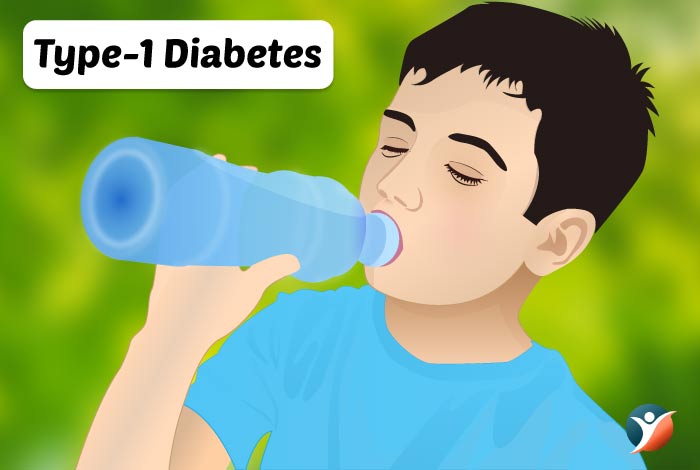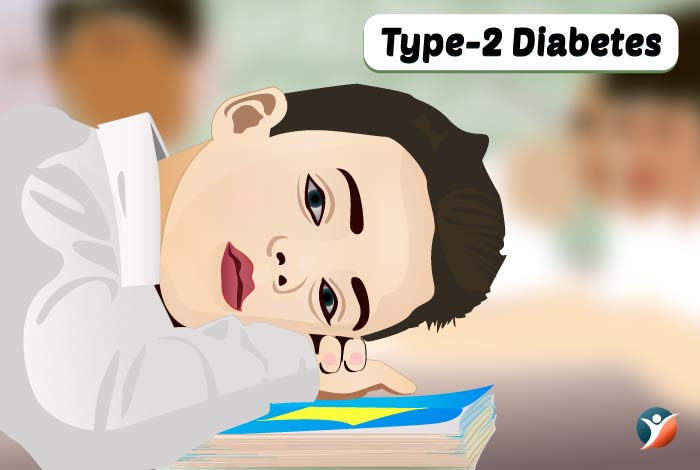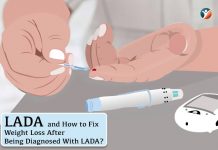
Signs and Symptoms of Diabetes in Children- Immediate Measures

Diabetes in children can be absolutely heartbreaking but knowing the signs and symptoms of diabetes in children can help you in preventing any serious complications.
Recognizing these signs can help you in early diabetes diagnosis and as a parent of a diabetic child, you can take immediate measures to fight any medical emergency. Read-on to know both obvious and sneaky symptoms of diabetes in children and learn what can you do in times of abnormally high or low blood sugar levels. This might help you in taking better care of your diabetic child.
Table of Contents
- Diabetes in Children
- Signs and Symptoms of Diabetes in Children
- Immediate Measures You Must Take, During Diabetes Emergency
- Conclusion
Diabetes in Children
Diabetes is indeed an intimidating condition and in children, it is quite worrying situation for the parents. Generally, type-1 diabetes starts in childhood and requires insulin to manage the condition.
Type-1 diabetes is less common and affects around 5% of all the people suffering from diabetes. However, type-2 diabetes which was earlier believed to be “adult-onset” is now also common in teens and even pre-teens. Due to increasing instances of obesity in children, doctor now also look for type-2 diabetes in children. Let’s learn what are the symptoms and signs of diabetes in children.
Signs and Symptoms of Diabetes in Children
Most of the parents bring their children to doctors, if they observe their kids drinking more and urinating even more. Children generally drink as much juice or liquids as are given to them and then they urinate several times. It is not necessarily diabetes, always. Read-on to know what signs and symptoms might indicate that your child has developed diabetes.
Type-1 Diabetes:

The signs and symptoms of type-1 daibetes or juvenile diabetes generally develop quickly. These signs might develop just within few weeks. Here are signs to look for:
Excessive Thirst And Urinating More Often: Too much sugar build-up in your child’s bloodstream pulls fluid from the tissues. Eventually, your kid might feel more thirsty and drink more fluids (polydipsia). As a result, he or she would urinate more (polyuria). Your toilet-trained kid might also often experience bed-wetting.
Extreme Hunger: Without enough insulin to get sugar utilized, your child might lack energy. In order to cover up for this energy loss, he or she might feel more hungry (polyphagia).
Fatigue: Lack of sugar in your child’s cells might make him feel more lethargic and tired.
Weight Loss: Despite eating enough to statisty his or her hunger, your child might still lose weight. This weight loss can be sudden at times. Without sufficient energy supplies, your child’s muscle and fat stores might deplete continously. Unexpected and unexplained weight loss is one of the most common signs of type-1 diabetes in children.
Dry and Itchy Skin: At times, due to lack of available fluids, your child might have dry and itchy skin.
Breath That is Fruity-Smelling: Burning fat stiores for energy instead of sugar produces certain ketones that might lead to fruity breath odor.
Behavioral Changes or Irritability: Besides mood problems, your child might also have difficulties in performing well at school.
Blurred Vision: If your child has high-sugar concentration in his or her bloodstrem, fluids are likely to be pulled out from his or her eye lenses. This might cause difficulty in focusing things clearly.
Yeast Infections: Young girls might have yeast infections due to type-1 diabetes. Babies might have diaper rashes due to yeast infection.
Delayed Healing of Wounds: High amounts of glucose in the blood impacts blood flow and as a result, immune cells can’t function properly. This explains the delayed wound healing.
Diabetic Ketoacidosis: Diabetic Ketoacidosis is not an early sign of diabetes but several new cases of type-1 diabetes in children are diagnosed by determining that his or her symptoms are caused due to diabetic ketoacidosis. Symptoms of this condition include the following:
1. Abdominal pain
2. Vomiting
3. Nausea
4. Breathing which might be deep, rapid or heavy
5. Fruity odor
6. Dehydration
7. Diminished neurocognitive function
8. Coma
Type-2 Diabetes:

Unfortunately, type-2 diabetes in children might not have any symptoms. This might make its early diagnosis rather hard. Most of these symptoms appear after few years of diabetes initiation. These symptoms include:
- Type-1 diabetes symptoms such as increased thirst, frequent urination, extreme hunger and weight loss
- Increased risk of infections and frequent infections
- Bruises and cuts that heal slowly
- Blurred vision
- Fatigue
- Tingling or numbness in feet or hands
As children with type-2 diabetes, do not have any common symptoms of diabetes, the doctor might look out for other symptoms and risk factors. These include having acanthosis nigricans (darkening of neck area) or stretch marks, being overweight or having family history of type-2 diabetes. These factors can indicate type-2 diabetes in children which can later be confirmed by hemoglobin A1C tests.
Infections in Children with Diabetes:
Children with type-1 diabetes might frequently experience other symptoms like vomiting, cough, hay fever or a sore throat. Any such infections might also lead to positive diabetes diagnosis. The child might be drinking enough water to keep up with the frequent urination. Once he or she is sick, the water intake is significantly reduced. This could lead to dehydration and diabetic ketoacidosis, which can even turn fatal.
With this, let’s learn what a parent with a diabetic child should do in emergency situations.
Immediate Measures You Must Take, During Diabetes Emergency

Keeping close watch on blood glucose levels of your child to avoid any lows and highs is crucial for parents who have a diabetic child. Parents who have children with diabetes should know that their kids have diet restrictions and also their activity levels need to be closely monitored.
Diabetes can be a serious trouble throughout a patient’s life. In the beginning, treatment and management of the disease can seem rather complicated.
Understanding how diabetes will affect your child, being patient and flexible are all essential to manage diabetes.
Few points to keep in mind when you have a kid with diabetes:
- You might need to deliver insulin injections initially and even if your child doesn’t need them, you should learn how to give them. Two major delivery sites where you can administer insulin are above the abdomen and in thigh, but it is better to ask your health-care team.
- You should know about the symptoms of low blood glucose and other complications including diabetic ketoacidosis. Besides recognizing these symptoms, you should know what to do in such cases.
- Keep a close watch on your child’s blood sugar levels. When they are old enough, you should teach them how to monitor blood glucose levels. In the same manner, they must also learn to administer their insulin injections.
- Educate people about your child’s diabetes and also let them know what they can do in any emergency.
- Make sure that glucose is always available with you to help in case of abnormal blood sugar levels. Also, keep other medications spare in cases of any emergency.
- Make your child wears a medic alert bracelet for diabetes such that in any case of emergency doctors can initiate proper treatment for him or her.
Diabetes can actually become serious, if your blood sugar levels are either too high or too low. Let’s learn what can you do as a parent of a diabetic child.
Know When It Is an Actual Diabetes Emergency?
An increasing number of incidents to call ambulance in case of mild hypoglycemia or hyperglycemia are observed all around the globe. In many cases, the condition was treated successfully before ambulance arrived.
This does not mean that situations like “hypoglycemia” are not an emergency, but instead you must know when a situation is really an emergency. It would in-turn prevent unnecessarily calling an ambulance.
Know When to Call an Ambulance:
When your child has very high or very low blood sugar levels that pose an immediate danger, you should call an ambulance immediately. If you or anybody else around is not confident enough of handling the situation, you must call an ambulance. This would help in preventing any life-threatening situations including ketoacidosis and Hyperosmolar Hyperglycemic Nonketotic Syndrome. If your child, who has diabetes is unconscious, you should call an ambulance right away.
Let’s discuss what you can do in the below-mentioned situations:
Severe Hypoglycemia:
Insulin dose can lead to severe hypoglycemia and in such cases, it can be fatal, if not treated. You can recognize severe hypoglycemia by the following signs:
- Unconsciousness
- Convulsions or fitting
- Weakness or hunger
- Confusion
- Sweating
- Rapid pulse
- Deteriorating levels of response
- Trembling
Hypoglycemia can be treated at home by taking sugar. If your diabetic child can have glucose gel, help him or her to take it. Additionally, give him or her something sugary to eat such as a fizzy drink, fruit juice, three teaspoons sugar or sugary sweets.
If the child improves quickly, you can give them more sugary food or beverages and make them rest for an hour or so.
But, if you don’t have sugar around or there is no betterment in their condition even after sugar consumption, glucagon injection can be administered. If you have glucagon, you must check its expiry date and follow the instructions on the kit. In case you and people around you are unsure about administering glucagon, you can call an ambulance.
Image:
Severe Hyperglycemia:
- Too less insulin can lead to high blood sugar (hyperglycemia).
- The following signs can indicate hyperglycemia:
- Dry or warm skin
- Rapid breathing and pulse
- Fruity smell breath
- Excessive thirst
- Drowsiness
If it is not treated, it might lead to child’s unresponsiveness or diabetic coma.
Therefore, it’s important to take them to a doctor for emergency treatment.
Preventing Other Emergencies:
Generally, non-severe hypoglycemia can be treated by taking glucose. You can give your child a slower acting carbohydrate like fruit or bread. If you suspect diabetes ketoacidosis, you should take your child to hospital immediately or call an ambulance.
While the ambulance is coming, if your child is unable to stand or sit, put him or her in a recovery position. Make sure to stay close to them to avoid any other issue.
In case you don’t know whether the blood sugar level is high or low, you should take your child to doctor immediately or check the blood glucose levels.
Preventing Emergencies at School:
For preventing any diabetes emergencies at school, it is best to let teachers and others who interact with your child regularly; know about his or her condition. Make sure your child wears a medic alert bracelet that mentions his or her diabetes type.
Tell your child’s teachers and others about how to recognize symptoms of diabetes and also let them know what to do in such cases. Always keep glucose gel and some sugary candies in your child’s school bag.
Preventing Emergencies When You Travel:
To deal with diabetes emergencies while on a holiday, make sure your child with diabetes has a travel insurance which includes cover for diabetes.It would help you to be prepared.
Make sure to ask your travel agent about emergency medical care at your resort or the destination you are traveling to.We advise you to learn pronouncing certain key words and phrases that are associated with diabetes in the area or country you will be visiting. If you have to use another language for communication, try to keep it simple as much as possible.
Conclusion
Diabetes in children can be diagnosed early if you know its signs and symptoms. This could help you and your child to learn how to deal with this life-long illness.
This way, you and your child will be in a better situation to manage diabetes. With proper care and regular blood glucose monitoring, you can prevent almost all of the diabetes complications.
You should also know what to do in case of any medical emergency. It is advisable to educate people about your child’s diabetes, who regularly interact with him or her including teachers. Let them know how to recognize a diabetes emergency and what to do in such cases.
Did you enjoy reading our article? Leave your comments and feedback in the comments section below. Do you have any other tips and advices for parents of a diabetic child? Let us know below. We look forward to sharing more tips with you. For updates, watch out this space.





